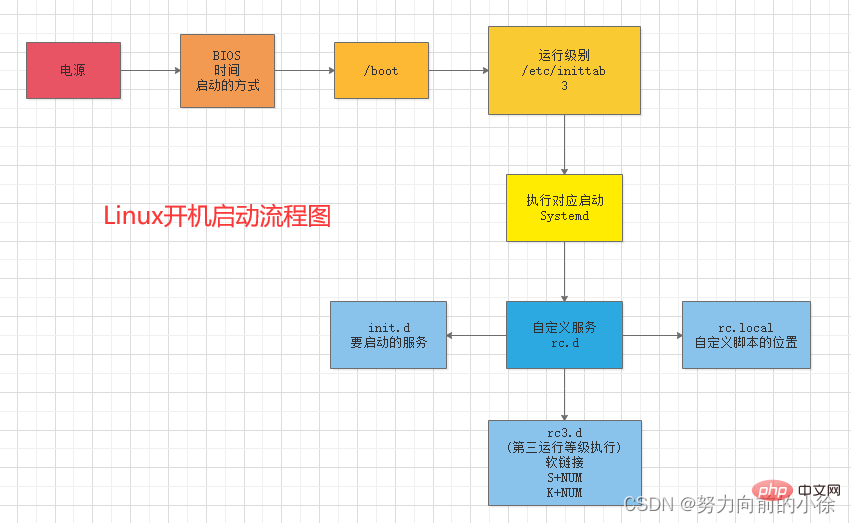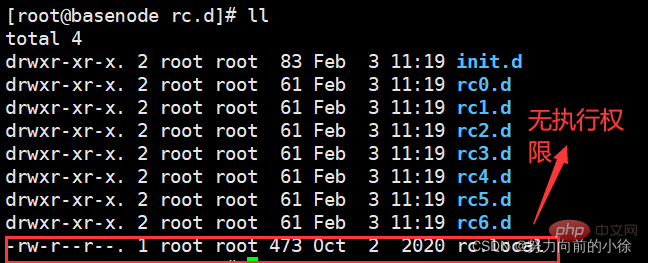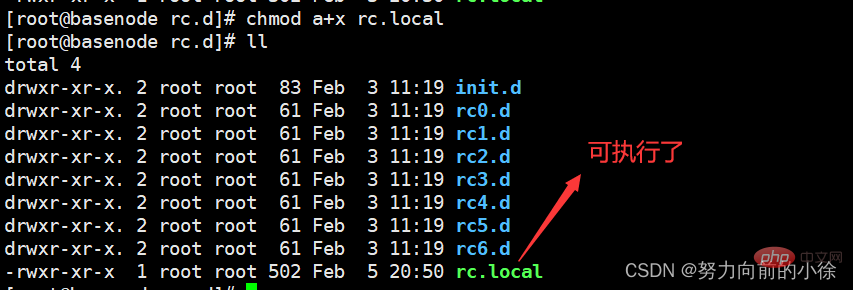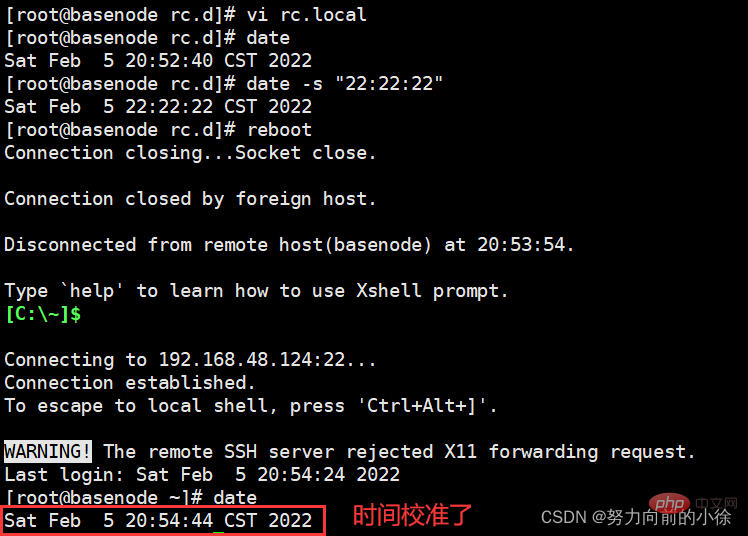systemctl status crond.service
 Operation and Maintenance
Operation and Maintenance
 Linux Operation and Maintenance
Linux Operation and Maintenance
 An in-depth analysis of the system task settings of Linux study notes
An in-depth analysis of the system task settings of Linux study notes
An in-depth analysis of the system task settings of Linux study notes
This article brings you relevant knowledge about system task settings in Linux, including issues related to the system startup process, system services, self-starting services and scheduled tasks. I hope it will be helpful to everyone.

System startup process
- Start the computer's hardware (BIOS)
- Read time
- Select Corresponding startup mode (USB HDD EFI)
- If it is a Linux system, go back to the /boot directory and boot the system to start
- The computer system starts to start and reads the initialization Configuration file
- vi /etc/inittab
- Controls the running level of the computer when starting runlevel
0 ##halt (shut down) 1 Single user mode 2 Multiuser, without NFS (multi-user mode, but no network status) FS-->FileSystem ##3 Full multiuser mode (multi-user full version mode) 4 unused (reserved mode) 5 X11 (User Interface Mode) 6 reboot (restart mode) - id:3initdefault: The default runlevel is 3
- Start starting the corresponding services and components with runlevel=3
- Start to boot the public components by default or Service
- vi /etc/rc.d/rc.sysinit
- Start loading the service corresponding to runlevel
- vi /etc/rc3.d
- K: Services that need to be turned off when shutting down
- S: Services that need to be turned on when starting up
- The numbers represent the order of turning on or off
All The files are all soft links (shortcuts), and the link address is /etc/init.


- ##When the startup is completed, all services
##System services
You can use the chkconfig command to view the services of the current virtual machine.- By viewing, you can know that different levels correspond to each service and confirm that it will start automatically during this boot.
- After the boot is completed, you need Use the service (CentOS6) Systemctl (CentOS7) command to control the opening or closing of the service
- rc.local
- (When this file has execution permission, it will be executed automatically after booting) First create the folder where the script is stored
- mkdir -p /usr/local/scripts
- vi hello.sh
- Give execution permission


- Give rc.local execution permissions
- mkdir -p /usr/local/scripts



 ##chkconfig
##chkconfig- First cancel the execution permission of rc.local, and then start testing
chmod a-x rc.local
Copy after login-
-
 Create automatic startup at boot Script file
Create automatic startup at boot Script file
vi schoolntpdate.sh
Copy after login #!/bin/bash #chkconfig:2345 88 99 #description:schoolntpdate.sh ## 开机自启动同步时间 yum info ntp && ntpdate cn.ntp.org.cn
Copy after login- Set execution permissions
chmod a+x schoolnptdate.sh
Copy after login-
- Copy the script to /etc/init.d directory
cp schoolntpdate.sh /etc/init.d/
Copy after login -
- Add to service
chkconfig --add /etc/init.d/schoolntpdate.sh
Copy after login -
- Restart Server
-
In the system service center, crond is responsible for periodic tasks
systemctl status crond.service
Copy after login-
- Add tasks and edit the current user’s task list
crontab -e
Copy after login
- Edit task
星 星 星 星 星 command 分 时 日 月 周 命令 第一列表示分钟1~59 每分钟用*或者*/1表示 第二列表示小时1~23(0表示0点) 第三列表示日期1~31 第四列表示月份1~12 第五列标识号星期0~6(0表示星期天) 第六列表示要运行的命令 *: 表示任何时间都,实际上就是“每”的意思。可以代表00-23小时或者00-12每月或者00-59分 -: 表示区间,是一个范围,00 17-19 * * * cmd,就是每天17,18,19的整点执行命令 ,: 是分割时段,30 3,19,21 * * * cmd,就是每天凌晨3和晚上19,21的半点时刻执行命令 /n: 表示分割,可以看成除法,*/5 * * * * cmd,每隔五分钟执行一次
Copy after login30 21 * * * /usr/local/rc.d/Lighttpd restart #上面的例子表示每晚21:30重启apache 45 4 1,10,22 * * /usr/local/rc.d/Lighttpd restart #上面的例子表示每月1,10,22日的4:45重启apache 10 1 * * 6,0 /usr/local/rc.d/Lighttpd restart #上面的例子表示周六、周日的1:10重启apache 0,30 18-23 * * * /usr/local/rc.d/Lighttpd restart #上面的例子表示每天的18:00至23:0每隔30分钟重启apache 0 23 * * 6 /usr/local/rc.d/Lighttpd restart #上面的例子表示每星期六的11:00重启apache * */2 * * * /usr/local/rc.d/Lighttpd restart #上面的例子表示每两小时重启apache * 23-7/1 * * * /usr/local/rc.d/Lighttpd restart #上面的例子表示晚上的11点到早上的7点之间,每隔一小时重启apache 0 21 4 * mon-wed /usr/local/rc.d/Lighttpd restart #上面的例子表示每月的4号与每周一到周三的11点重启apache 0 4 1 jan * /usr/local/rc.d/Lighttpd restart #上面的例子表示一月一号的4:00重启apache --(功能描述:显示年月日时分秒) date "+%Y %m %d %H %M %S"
Copy after login- Restart crontab to make the configuration take effect
systemctl restart crond.service
Copy after login- View the current scheduled task through crontab -l
- View the history of the task
vi /var/spool/mail/root
Copy after login- Clear task
crontab -r
Copy after login- Test
- Create a script that creates a folder
#!/bin/bash dname=`date "+%Y%m%d%H%M%S"` mkdir -p ~/$dname
Copy after login-
- Add a scheduled task and create a folder every minute

crontab -e #编辑定时任务
Copy after login

- #
systemctl restart crond.service #重启生效
Copy after login-
crontab -l #查看当前的定时任务
Copy after login- Check if created

-
- Clear tasks
Related recommendations: "Linux Video Tutorial"
- #
The above is the detailed content of An in-depth analysis of the system task settings of Linux study notes. For more information, please follow other related articles on the PHP Chinese website!

Hot AI Tools

Undresser.AI Undress
AI-powered app for creating realistic nude photos

AI Clothes Remover
Online AI tool for removing clothes from photos.

Undress AI Tool
Undress images for free

Clothoff.io
AI clothes remover

Video Face Swap
Swap faces in any video effortlessly with our completely free AI face swap tool!

Hot Article

Hot Tools

Notepad++7.3.1
Easy-to-use and free code editor

SublimeText3 Chinese version
Chinese version, very easy to use

Zend Studio 13.0.1
Powerful PHP integrated development environment

Dreamweaver CS6
Visual web development tools

SublimeText3 Mac version
God-level code editing software (SublimeText3)

Hot Topics
 What computer configuration is required for vscode
Apr 15, 2025 pm 09:48 PM
What computer configuration is required for vscode
Apr 15, 2025 pm 09:48 PM
VS Code system requirements: Operating system: Windows 10 and above, macOS 10.12 and above, Linux distribution processor: minimum 1.6 GHz, recommended 2.0 GHz and above memory: minimum 512 MB, recommended 4 GB and above storage space: minimum 250 MB, recommended 1 GB and above other requirements: stable network connection, Xorg/Wayland (Linux)
 Linux Architecture: Unveiling the 5 Basic Components
Apr 20, 2025 am 12:04 AM
Linux Architecture: Unveiling the 5 Basic Components
Apr 20, 2025 am 12:04 AM
The five basic components of the Linux system are: 1. Kernel, 2. System library, 3. System utilities, 4. Graphical user interface, 5. Applications. The kernel manages hardware resources, the system library provides precompiled functions, system utilities are used for system management, the GUI provides visual interaction, and applications use these components to implement functions.
 How to run java code in notepad
Apr 16, 2025 pm 07:39 PM
How to run java code in notepad
Apr 16, 2025 pm 07:39 PM
Although Notepad cannot run Java code directly, it can be achieved by using other tools: using the command line compiler (javac) to generate a bytecode file (filename.class). Use the Java interpreter (java) to interpret bytecode, execute the code, and output the result.
 vscode cannot install extension
Apr 15, 2025 pm 07:18 PM
vscode cannot install extension
Apr 15, 2025 pm 07:18 PM
The reasons for the installation of VS Code extensions may be: network instability, insufficient permissions, system compatibility issues, VS Code version is too old, antivirus software or firewall interference. By checking network connections, permissions, log files, updating VS Code, disabling security software, and restarting VS Code or computers, you can gradually troubleshoot and resolve issues.
 How to check the warehouse address of git
Apr 17, 2025 pm 01:54 PM
How to check the warehouse address of git
Apr 17, 2025 pm 01:54 PM
To view the Git repository address, perform the following steps: 1. Open the command line and navigate to the repository directory; 2. Run the "git remote -v" command; 3. View the repository name in the output and its corresponding address.
 Can vscode be used for mac
Apr 15, 2025 pm 07:36 PM
Can vscode be used for mac
Apr 15, 2025 pm 07:36 PM
VS Code is available on Mac. It has powerful extensions, Git integration, terminal and debugger, and also offers a wealth of setup options. However, for particularly large projects or highly professional development, VS Code may have performance or functional limitations.
 How to use VSCode
Apr 15, 2025 pm 11:21 PM
How to use VSCode
Apr 15, 2025 pm 11:21 PM
Visual Studio Code (VSCode) is a cross-platform, open source and free code editor developed by Microsoft. It is known for its lightweight, scalability and support for a wide range of programming languages. To install VSCode, please visit the official website to download and run the installer. When using VSCode, you can create new projects, edit code, debug code, navigate projects, expand VSCode, and manage settings. VSCode is available for Windows, macOS, and Linux, supports multiple programming languages and provides various extensions through Marketplace. Its advantages include lightweight, scalability, extensive language support, rich features and version
 vscode terminal usage tutorial
Apr 15, 2025 pm 10:09 PM
vscode terminal usage tutorial
Apr 15, 2025 pm 10:09 PM
vscode built-in terminal is a development tool that allows running commands and scripts within the editor to simplify the development process. How to use vscode terminal: Open the terminal with the shortcut key (Ctrl/Cmd). Enter a command or run the script. Use hotkeys (such as Ctrl L to clear the terminal). Change the working directory (such as the cd command). Advanced features include debug mode, automatic code snippet completion, and interactive command history.












 ##chkconfig
##chkconfig Create automatic startup at boot Script file
Create automatic startup at boot Script file






